How to propagate ficus?
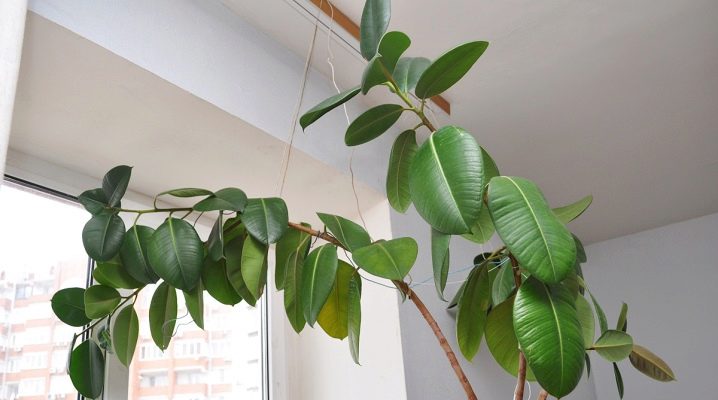
The genus of ficus includes more than five hundred different types of plants, both indoor and wild. But ficus is popular precisely as a houseplant. The main role in such popularity is played by the variety of forms of ficus. It may look like a small tree, liana, or bush. And also the genus of ficus is distinguished by a large number of variations in the shapes, colors and sizes of its leaves. Many also believe that ficus is an absolutely unpretentious plant, but this depends on its type - there are also quite capricious ones.
Reproduction of ficus requires the implementation of certain recommendations, so that the parent plant does not suffer, and the shoot gives roots and grows into a new healthy plant.
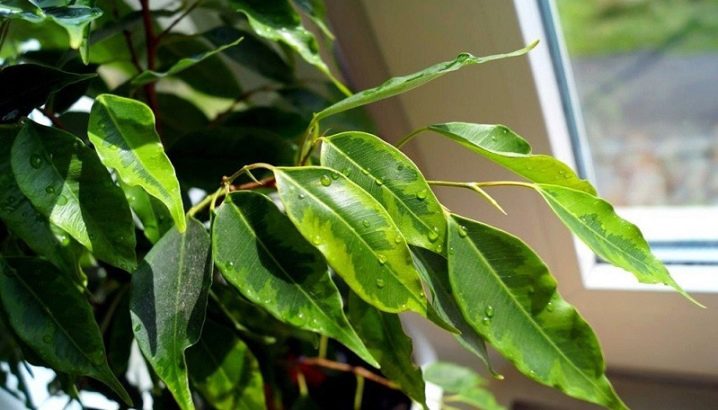
Peculiarities
In order to propagate the ficus correctly, it will be useful to define its type, but it is not necessary. The breeding methods listed below are suitable for all species. But, based on each specific type, you can choose the one that will be most comfortable. Ficus is an indoor flower, but with its own needs. They must be taken into account in the upcoming breeding. These features include love of warmth and dislike of bright light, preference for certain soil, periods of active and resting phases.
Low temperatures are contraindicated for ficuses, so the plant needs to maintain the optimal temperature and avoid sudden changes in it. This is especially true of the breeding season and winter: the sprouts will not survive at low temperatures and without providing them with the necessary temperature regime, too. Winter is not suitable for breeding ficuses, since the flower is dormant, and, most likely, the plant will not give roots and will simply die.
Before carrying out a transplant, you should read the instructions step by step in order to do everything correctly and get the desired result. If all the requirements and tips are fulfilled, it will not be difficult to propagate the ficus.
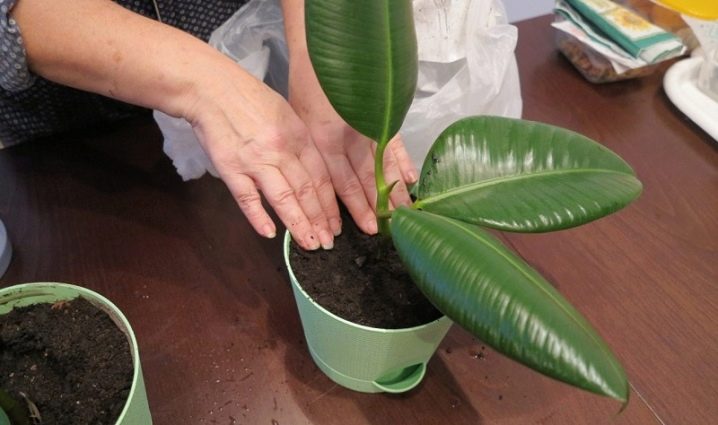
Preparation
Before carrying out the breeding process in any of the available ways, you need to prepare everything you need. It is better to prepare a special place where all subsequent actions will be carried out so as not to transfer the pot with the plant, tools, etc. from place to place during the process. And also to immediately provide the plant with everything it needs. If side shoots are required for reproduction, you can influence their growth in advance. This requires cut the ficus in a timely manner. Usually its top is cut off, after which shoots will begin to appear on the sides of the plant.
Depending on the method, special tools may be needed - these are ordinary scissors or a knife with sharpened blades, a stationery knife, a blade. A blunt tool is categorically not suitable, since they can injure both the plant itself and the future seedling, which will lead to death... If for reproduction, in addition to the cutting tool, special mixtures, containers for germination, and so on are required, all this must be prepared in advance. It is necessary to prepare the necessary soil and drainage.
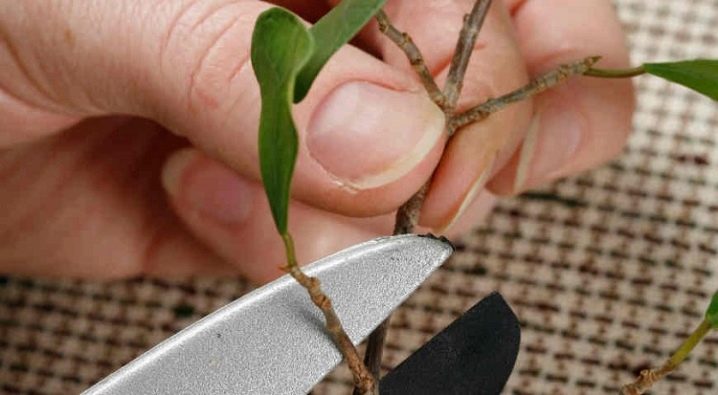
Be sure to prepare a place where the plant can take root. There are certain requirements for such a place.... The window sill will not be the best choice for the life of the ficus, especially on the sunny side of the apartment, since the sun's rays will be destructive for it. The best choice would be place in the shade. Another mandatory requirement for the place where the flower is kept is a sufficient amount of heat.Often room temperature is not enough for plant germination, then you need to prepare a small greenhouse in advance. This is worth thinking about before doing any manipulations with the plant. If you do not provide him required temperature conditions immediately after placing a future seedling in water or soil, you can harm it and not get the desired result.
The timing of the propagation of ficus is very important. Summer or spring is suitable, in winter it is impossible to reproduce. In the cold season, the ficus becomes very sensitive to sudden changes in temperature and can die when trying to reproduce. And also in winter, the plant hibernates.
Most often, it is advised to start breeding in early spring, when the plant wakes up from hibernation and enters the phase of active growth.
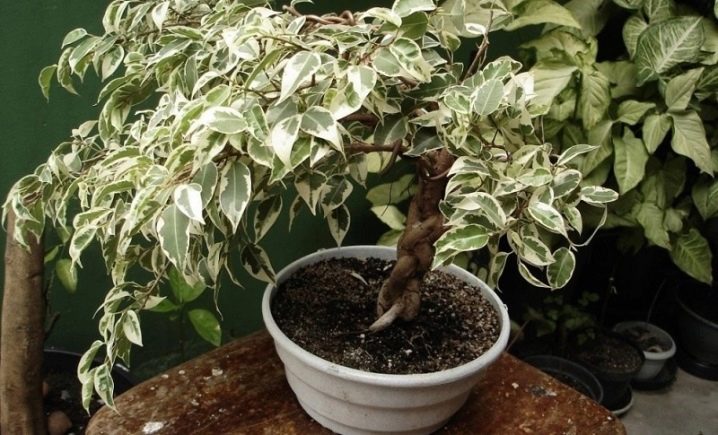
Reproduction methods
Despite the variety of species of ficuses, everything is quite simple with their reproduction. They all reproduce in the same way, which simplifies the task for the owners of these indoor plants. For all types of ficuses, there are breeding methods such as:
- cuttings;
- layering;
- sheets;
- seeds.
All these methods are suitable for planting ficus at home.
Due to the characteristic features of each of the methods, you can choose the appropriate option for each specific plant.

Cuttings
Propagation by cuttings or cuttings is one of the easiest ways to get a new plant from an existing one. This method is great for deciduous species of ficus, for example, for Benjamin's ficus. In this way, you can get completely new from the branch from the top of the plant. An important condition for cuttings is that it is not carried out with plants under 2 years old; lignified shoots are best suited for this method. If you try to apply this method to a young plant, it injures him. As a result of injury, the shape of the ficus can deteriorate and its growth can significantly slow down.
Important! From the top of the ficus, you need to measure about 10-15 cm - this will be the future cutting. In this case, the distance to the first knot should be at least 1 cm.
For the reproduction of those types of ficuses that have large leaves, the cutting can be taken not only from the top, but also from the stem. But then an important condition for the future cutting is the presence of leaves. If there are at least three leaves on the lateral process, it will do. These leaves are not cut off. If there are too many leaves on the handle, it is better to partially remove them with a knife, leaving those that are located at the very top.
Important! The stalk should not be a bare stick, but it cannot be completely in the leaves. Leaves consume moisture, when there are too many of them, they deprive future roots of the necessary moisture, preventing them from developing.
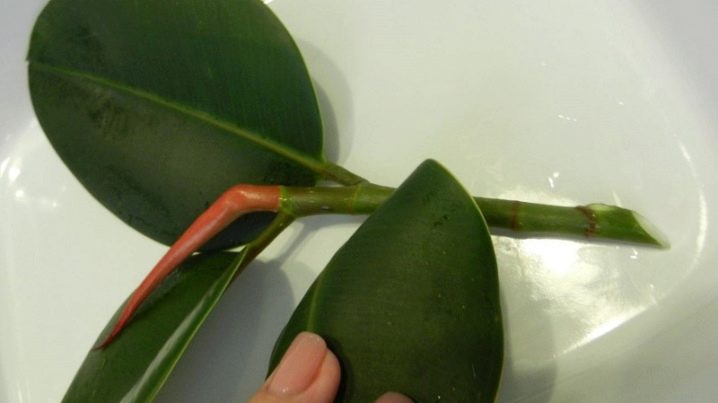
The cut is done with a sharp knife or scissors and always at an angle - so it will be easier for the cutting to absorb moisture. The cut must be rinsed with warm water to remove the juice and leave the cutting for a while so that the cut dries. Leaving the juice to dry on the cuttings can affect the rate at which new roots emerge, lowering it. To accelerate the formation of roots on the handle, it is advised to make a cruciform notch on the lower cut.
The stalk is placed in a container of water. Instead of pouring water, you can also line the bottom of the container with wet cotton wool. The container with ficus should be removed to a warm place for 3-4 weeks. During this time, the cutting will take root and be ready for transplantation. And also a sign that the plant is ready for transplanting, young leaves on the cuttings can serve.
Important! The ficus takes root at an average temperature of +24 degrees, so it is better to place the future seedling in a greenhouse if you are not sure that the room temperature will be enough, or if there are strong temperature drops during the day - this is often the case in spring.
It is better to plant the plant in a small pot.It is recommended to use peat and sand as a soil. If the room is still quite cold, the seedling can be covered with a transparent cover to maintain a higher temperature and kept warm. The stalk is periodically sprayed, and the plant itself is watered. If the seedling grew under a hood, before leaving it without a personal greenhouse, you need to carefully accustom him to room temperature.
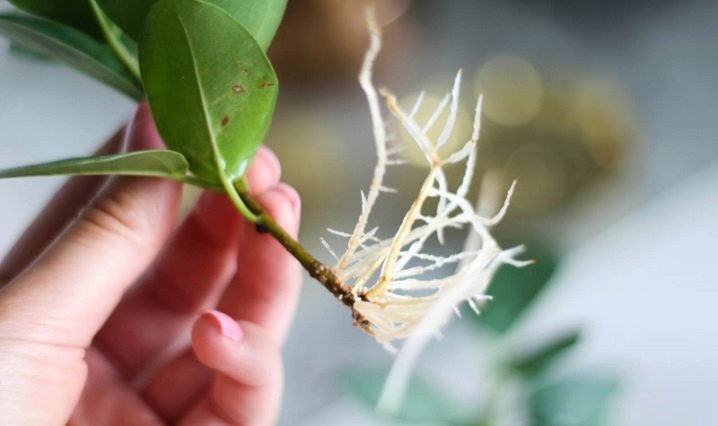
Layers
Reproduction by layering can be of two types: air and horizontal. Each of these species has its own characteristics, but both of them are more suitable for flower growers who already have experience in plant propagation. Propagation by air layers suitable even if the ficus stem is too bare. For propagation in this way, it is also better to use adult plants.
For propagation by layering, you must choose an escape not less than 50 cm in height. It is necessary to cut the leaf from the trunk at the height at which you want to get the cut. This must be done carefully and make sure that the bark is not damaged in the process. A shallow incision is made at the site of the cut from the leaves. A utility knife or blade is best suited for this purpose. Juice will stand out from the incision, it must be removed with cotton wool, constantly soaking until the secretion of juice stops. A match, toothpick, or small chip is placed in the incision to allow oxygen to enter the incision.
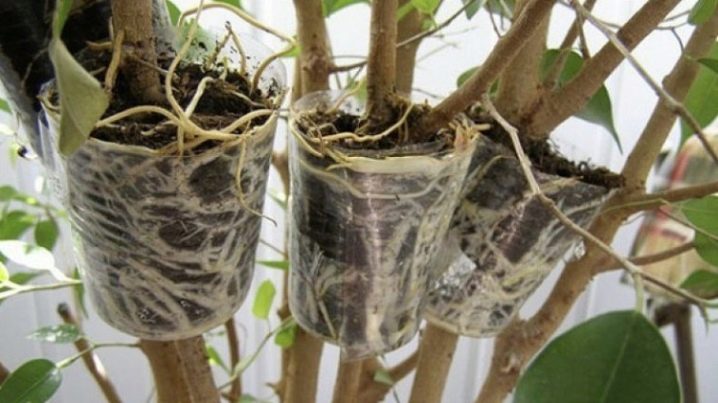
The place of the incision should be wrapped with a little moistened moss. It shouldn't be wet, just a little damp. The finished moss "tire" needs to be wrapped with cling film. It is advisable to leave a little air under the film and fix it firmly on the barrel. In the process of rooting, you need to ensure that so that the moss under the film does not dry out. If necessary, it must be moistened again.
Important! Instead of moss, it is also permissible to use soil enriched with peat, but moss remains preferable for this purpose.
The time of emergence of roots with this method of reproduction is 15–25 days. Shoots without roots cannot be cut off. Future seedlings will be ready for planting only when the root system is sufficiently developed. Only in this case, the shoot can be cut from the mother plant and planted in a separate pot.
Reproduction by horizontal layers is carried out with ficus with curly stems. In this case, the future shoot is not wrapped in moss. The stem is also stripped of leaves, grooves are made on the cut with a knife, and then fixed in the ground, after having processed the incisions with a rooting stimulator. When the cuttings are rooted, they can be detached from the mother plant and transplanted on their own.
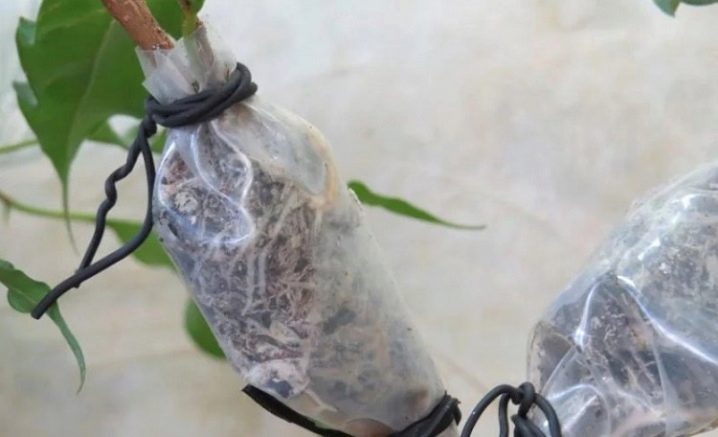
Sheet
With large-leaved species of ficuses, a new independent plant can be grown from a leaf. Reproduction in this way can be carried out with the best quality large leaves. You need to cut off the sheets with a small part of the internode. Two cuts are made: the main one and another oblique, so that the root system develops faster. The leaf should be rinsed under running water or soaked to get rid of unnecessary juice. If this is not done, the process of root formation can be significantly delayed. It is better to treat the cut with a root formation stimulator, which is not necessary, but it will give more chances that the leaf will turn into an independent plant.
Before planting the leaf, you need to prepare the soil: usually it is soil mixed with a small amount of sand and vermiculite mineral. Drainage must be sent to the bottom of the tank for disembarkation. The container must have holes to drain excess liquid. The sheet must be carefully twisted, tied with a soft thread or secured with an elastic band. Deepen the leaf to the petiole, not higher. In 3-4 weeks the sprout should finally take root in the soil. The required temperature for the development of the root system is about +27 degrees.
So it is better to remove the container with the leaf in the greenhouse if the room temperature is lower than required.
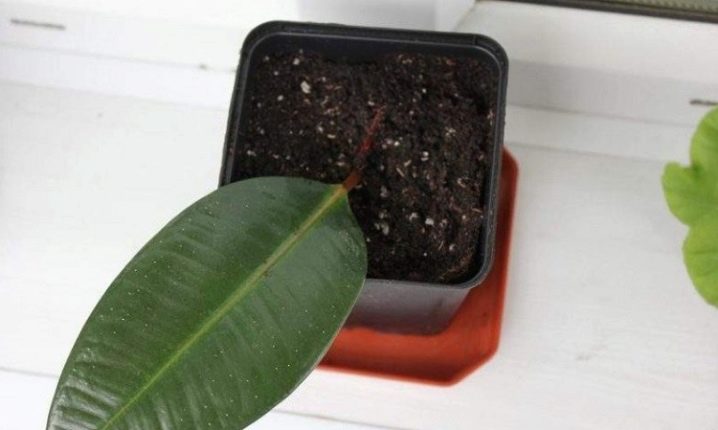
Seeds
It will not work to breed ficuses from seeds allegedly obtained at home. What some people take for seeds are actually flower buds. Pollinating insects are required for the formation of ficus seeds. If you want to grow ficus from seeds, you need to purchase them in the store. Seed propagation of ficus is the most difficult of all methods.
Before sowing seeds, they need to be treated with a substance to get rid of spores and fungi "Fungicide" and a growth stimulant. As a soil for the future ficus, it is worth choosing a mixture of peat moss (sphagnum) and peat. A mixture of two parts of ordinary humus and one part of sand is also suitable. Before planting the plants, it is better to sterilize the soil with steam. A flat container is best suited for planting seeds - it will be convenient to cover it with a film, monitor the moisture content of the soil and the behavior of the seeds. Drainage holes are required to drain excess fluid. The container must be clean and disinfected.
The soil must be poured into a container, lightly crushed and sprayed. You cannot water the soil. Seeds are laid out on the moistened soil. Do not lay them out too close to each other so that they do not experience a lack of illumination.
During germination, you need to ensure that the soil is moistened.
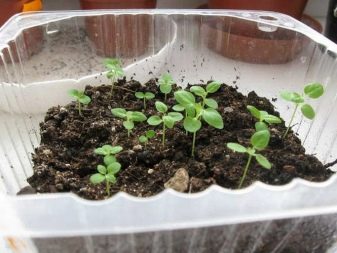

The temperature during the germination period should not fall below + 22– + 23 degrees. If you allow direct sunlight to hit the seeds, they will die. The film must be periodically opened and closed so that the seeds have access to fresh air. Do not overmoisten the soil. Instead of film, you can use glass, which will be more convenient. When the seeds sprout, they need to be accustomed to the room climate. For this, it will be convenient to put the glass on supports, ensuring a constant flow of air to the sprouts. This is left for 3-4 days, allowing the sprouts to get used to the new temperature regime.
It can take a long time for the seeds to take root. In this case, you need to be guided not by any time frame, but by appearance. The seed should take root, and the next step will be the appearance of the leaves. The sprouts are ready for transplanting when they have four or more leaves. They can be planted in a common container, but be sure to retreat a distance of about 4–5 cm.
Young sprouts of ficus obtained from seeds require frequent replanting. In the first eight months of life, this is done several times. This frequency of soil change has a beneficial effect on the root system, stimulating its development. After these two months, young plants can be planted separately and start feeding with fertilizers.
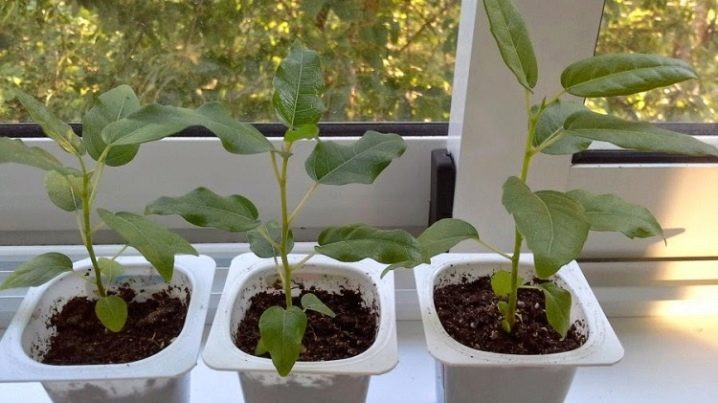
Follow-up care
Care must be taken to ensure that the young plant receives enough light. Direct sunlight is still contraindicated for him, but light is an important condition for the development of a flower. If there is a lack of light, you can use additional devices, for example, lighting, which is usually used for seedlings.
It's important to take care of the temperature. In order for the plant to live in the right rhythm (in the spring the growth phase, and in the winter the dormant period), it is necessary to maintain a certain temperature. In summer, the temperature should remain around + 25– + 28 degrees, in winter - + 15– + 18 degrees.
The temperature rule is the same for all types of ficuses.
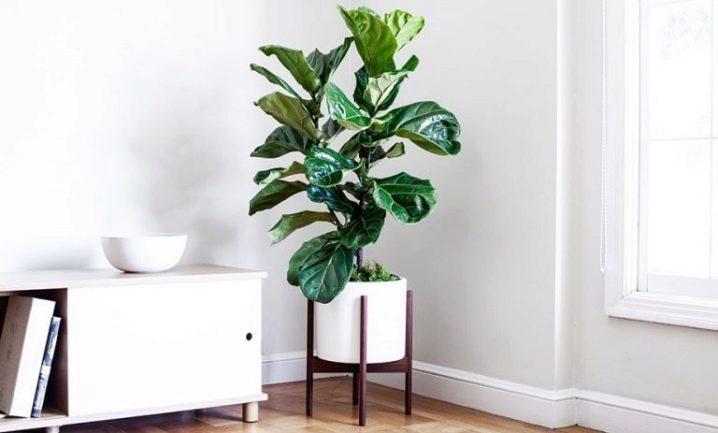
Ficus does not like an abundance of water, but its absence is also hard to bear. The soil should not be dry, but you should not water it too much. It is better to provide a slightly damp soil, and in the summer, in addition to watering, wipe the leaves of the plant with a damp cloth and spray it with a spray bottle. This is not required in winter.
A young plant is advised to transplant once a year. With each transplant, you should choose a pot 2 sizes larger for it. Old ficuses also require periodic replanting, but not so often. When replanting, part of the old soil must be replaced with a new one.
Spring and summer for ficus is a period of active growth. At this time he needs additional feeding. It is desirable to carry it out about once every 2 weeks. Ficus can be fed with a solution of universal fertilizer for indoor plants. The ficus soil should be light but nutritious. Fertilizers do not have to be added directly to the soil, it is enough to dilute them with water and feed the plant when watering.
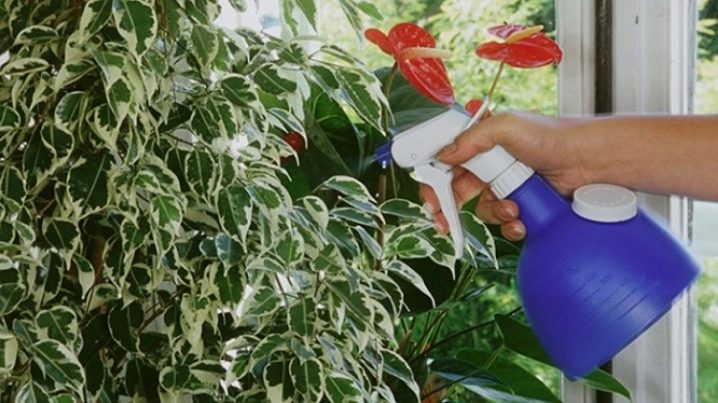
You can find out how to easily and quickly propagate Benjamin's ficus below.































The comment was sent successfully.